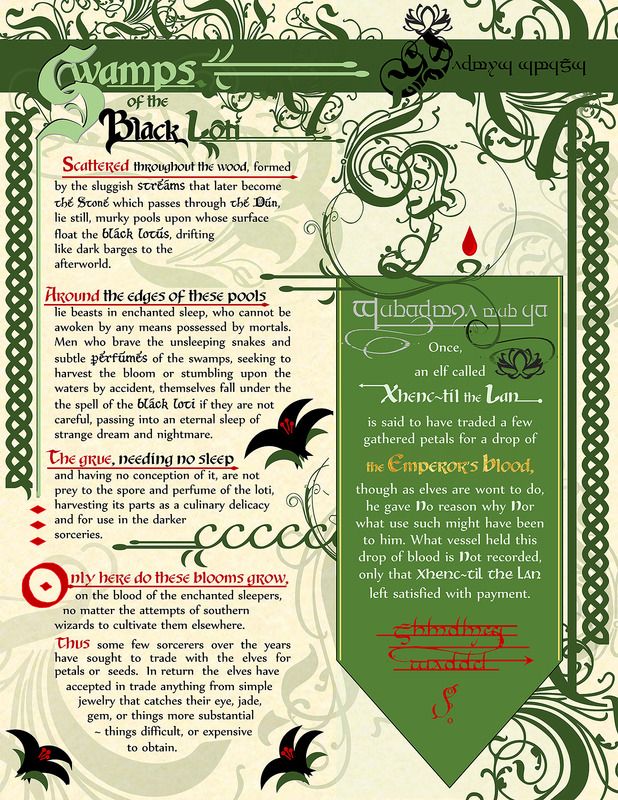 Raven Daegmorgan has delivered a top grade rant that will be of interest to fans of old style fantasy:
Raven Daegmorgan has delivered a top grade rant that will be of interest to fans of old style fantasy:
…Elves in modern fantasy fiction suck — nigh every depiction of them post-Tolkien, in that they are not portrayed as otherwordly, supernatural, whimsical, fickle and dangerous others. That is, they are not fey, they are far too human….
The modern simulacrum found in everything from The Sword of Shannara to any Dungeons & Dragons book you’d care to mention lack resemblance to the historical myths, fairy tales, and early weird fiction that preceded the fantasy genre, and even Tolkien’s work from which they derive, though he himself drew upon the myths and stories of elves from mythology and fairy tale.
This is not to berate and sneer down my nose at either example, as the former was one of my favorite books growing up, and products of the latter fill shelf-upon-shelf in my home; rather, to point out, at their worst, elves in pop-culture are cheap cardboard analogues for Native Americans. With pointy ears. Or (though potentially “better” at least in terms of cultural sensitivity) a stand-in for snotty, long-lived humans who cast magic spells and live in tree forts. And have pointy ears.
That is, they mainly function to create a cheap exoticism, where humans could just as easily have been swapped into their place, with their inclusion in modern fantasy having become a form of social signaling that a work is about ‘magic’ and ‘fantasy’ and all that itself implies.
Part of this is due the inherent difficultly in portraying something alien to human behavior and experience: we end up throwing a metaphorical “funny hat” on it (a term borrowed from similar critiques in science fiction, where most depictions of aliens suffer from this same issue), that is, differentiating them via cultural trappings, because human behavior is the only kind of behavior we truly know and understand. We anthropomorphize them.
A greater part, in this case, is due divarication: the process by which information separates itself from its source, changing and simplifying; like a game of Telephone (‘Chinese Whispers’, as it is known outside the US).
Modern fantasy is, in the main, derived from Tolkien, but the modern pseudo-Tolkien impersonations mimed only the most obvious and blunt characterizations from that author’s works: long-lived, magical, haughty, wood-dwelling, pointy-eared archers, and so on, missing the subtleties of his own borrowings from mythology.
What we have been left with is essentially a photocopy of a photocopy. And often even a photocopy of that second photocopy, now that the pop-culture depictions, which grew from Tolkien’s once-standard reference, have become the new standardized reference.
That is precisely what happened and also a great way to put it. And you see a similar pattern happening in response to the other two giants of 20th century fantasy, Robert E. Howard and H. P. Lovecraft. Swords & Sorcery as most people have experienced is but a pale imitation of Howard’s Conan stories. And today’s “Lovecraftian” tales have about as much to do with Lovecraft’s work and Tolkien’s does with the “Tolkienesque”.
And while some people are content just to complain about this sort of thing, others go beyond that and do something about it. Daegmorgan is definitely part of the latter group. As part of his Patreon, he is bringing his own vision of Elfland to life by creating a fantasy guidebook in the style of illuminated medieval manuscripts. Check it out!
As a rule, I threw out any submissions that had elves. I should probably add that to my guidelines..
-
This is an _very old_ lament that has been popping up periodically in fanzines and reviews since the 1980s.
As a result, numerous authors have bucked the trend, creating elves that are more exotic. I am fond of CJ Cherryh’s examples (cf The Tree of Swords and Jewels/The Dreamstone) but there are dozens more in fantasy fiction where authors did make the effort.
Even among D&D fans, efforts to create exotic elves popped up every time someone read Appendix N, then picked The Broken Sword and Three Hearts and Three Lions and said “Anderson Elves Are More Fun!” (Including TSR, cf. their appearance in Queen of the Demonweb Pits…)
Runequest also its own stranger types.
Still, we may adapt Sturgeon’s Law: 90% of elves are crap.
Mostly the D&D-type weak sauce wood elves tediousness descend from their nature as Chainmail wargames units (“split move and fire, benefits in wood terrain”) and a desire to play balance PC character classes.
Same thing with orcs. Tolkien’s orcs have a specific origin and nature.
-
A neat thing about Orcs that most people overlook because of how they’re portrayed in other fantasy media is that they were not particularly different from humans physiologically and could be mistaken for rough looking men under many circumstances. Also, in between varying wars at the Dark Lord’s behest, they got on well enough with the non-elf-aligned human tribes during the first age.
-
A good rule of thumb is that if an author is lazy enough to use Tolkien’s “orc” for a humanoid goblin-like monster, they’re probably not worth bothering with at all in the first place.
Minor exceptions for those doing a deliberate parody or riff (e.g., the Monster Hunter orcs).
-
at their worst, elves in pop-culture are cheap cardboard analogues for Native Americans…
Huh. I always thought they were French.